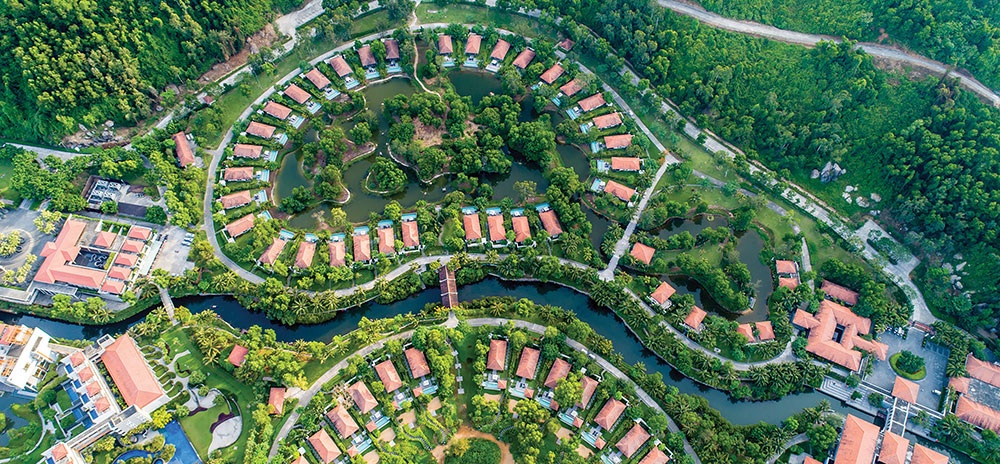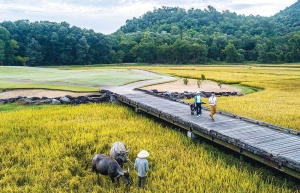Golf course real estate setting trends
Appearing in the 15th century in Scotland, golf quickly developed throughout Europe and North America before reaching Asia – the fastest-growing market today.
In Vietnam, the first golf course built was the Dalat Palace Golf Course in 1990. From 2010 onwards, golf entered its golden age in Vietnam. Dozens of courses were built, the number of players spiked to tens of thousands, golf tourism was promoted heavily, and production and distribution activities of related products were born.
According to statistics from the Vietnam Golf Association (VGA), there are around 80 golf courses in operation across the country. It is expected that the number will reach 200 by 2025. The localities with the strongest golf development are Hanoi, Hoa Binh, Bac Giang, Quang Ninh, Danang, Vung Tau, Dong Nai, and Binh Duong. Participating in this game are big names such as Geleximco, Vingroup, BRG, FLC, Sun Group, and Sovico Holdings, as well as overseas names such as Asian Coast Development and Tanzanite International.
In 2019, Vietnam welcomed around 1.5 million international golfers, bringing revenues of VND4.5 trillion ($195 million), according to the Vietnam Golf Tourism Association.
 |
| Golf course real estate setting trends |
ATTRACTING BUYERS
The boom of golf has promoted the related real estate segment. Golf course projects with integrated real estate and services were born and quickly created an investment fever.
Three groups of customers who have a high demand for this type of real estate include investors who have a hobby of collecting special, rare properties, golf enthusiasts, and investors who are looking for green living space but full of facilities and services.
There are many factors that make up the special attraction of golf course real estate. Among those are a unique location, limited products, the ability to rent with high yield thanks to a focus on high-class customers, and the great potential for increasing the asset’s value.
Statistics from the VGA show that among the 80 golf courses in operation across the country, 32 courses meet regional and international standards and half of that can be combined with residences.
Nguyen Van Dinh, chairman of the Vietnam Association of Realtors said, “The golf courses available with residences are now offering hundreds of products, a very limited number compared to demand.”
Dinh added that golf course real estate, typically golf villas, is a high-class product, aiming to serve a certain customer base with extremely high benefits for the project owners. “Golf villas will be the segment that investors aim for. I believe that investing in those products creates long-term and sustainable benefits because its value will increase for sure,” Dinh said.
According to real estate company DKRS, worldwide golf courses are considered "diamond businesses" because the average selling price of this product is always higher than other high-end products in many countries. For example, in the US, a golf course project has a selling price about 10 per cent higher than other products.
Meanwhile, the selling price of a golf course villa in the UK can be double the price of an ordinary one in the same area. Villas and apartments next to golf courses in the world often cost millions of dollars.
In Vietnam, according to a survey by DKRS, golf resort projects have a selling 19 per cent higher than other high-end resort products, and from 20-35 per cent in projects located near big cities.
“That means the investment ratio in Vietnam is at an attractive level. The value and exploitation of golf villas will be very good and people who invest in this product are investing for the future," said DKRS.
CLASSY HUNTERS
Many investors choose to buy golf course villas as a second home so that they can both relax every weekend with family and friends, and can make a profit by renting while real estate value increases steadily every year from 10-25 per cent depending on each project and location.
Nguyen Le Hai Dang, an independent real estate strategist, said that majority of golf real estate hunters were the ones who have a hobby of collecting special and limited properties and golfers.
“A large number of businesspeople are playing golf for health improvement and for connecting their business network. In addition to that, investors look for green and fresh living spaces,” Dang said.
He added that real estate projects combined with golf courses must be classy and fully equipped to serve the needs of investors as well as their partners. In addition, the project must be convenient for traffic and well connected to economic business areas.
The strong increase of the rich class in Vietnam makes the demand for real estate associated with golf courses even greater.
According to Knight Frank’s latest Wealth Report released in March, the number of ultra-high-net-worth individuals in Vietnam is set to grow by 26 per cent between now and 2026. The growth in Vietnam is mirrored by the dynamic Asia-Pacific region, which trails only North America in the growth of this demographic.
“We have witnessed prime apartment sales break the $10,000 barrier this year driven by local demand, and with that 26 per cent on par with Hong Kong and Taiwan, we can see the potential for ongoing growth well into the future beyond that,” said Alex Crane, managing director for Knight Frank Vietnam. "Vietnam will be represented prominently in this report in the next few years as economic fundamentals and Vietnam’s position on the world stage continue to accelerate."
Hoang Duc Viet, sales director of Tran Anh Group, shared that compared with other countries around the region, the number of players and golf courses in Vietnam is still very modest, with nations like Thailand boasting many hundreds of golf courses and millions of players.
“Therefore, the potential of golf courses combined with real estate will be an investment trend that many people are interested in, especially for projects located not too far from Hanoi, Ho Chi Minh City, Danang, and Dalat,” Viet said.
Mauro Gasparotti - Director, Savills Hotels Asia-Pacific Vietnam has witnessed a large increase in entertainment and sports offerings in the past few years, following the robust growth of tourism development. Among those, golf courses have been some of the most favourite components that developers prefer to embrace in their master planning. If this is planned and executed properly, a golf course component could help enhance the project’s and destination’s appeal. To date, there are nearly 80 operating golf courses in Vietnam, and another 40 are underway. Around the globe, golf drives real estate development, which has seen many mixed-use projects offering new products. The most common real estate elements are residential villas or townhouses. These products are almost only used as a pure second home. While these are out of use, owners can lease them or authorise the developer or management company to lease their assets for rental income. The second type is the hotel and resort component, which is integrated into large-scale, mixed-use developments in major tourist destinations such as Phu Quoc, Cam Ranh, Danang, and Quang Nam. However, the number of developments is still limited as this requires substantial resources. The majority of integrated developments belong to Vingroup, BRG Group, KN Investment Group, Sun Group, and Novaland Group. Golf villas are gaining better traction in terms of attractive yields and potential capital gains. One of the best features of a golf course is to bring added value to a project’s master plan. It does not solely offer an element of business but also adds tremendous value in terms of landscaping. For this reason, it is often proposed as part of large-scale master plans aimed to elevate the value of the whole destination and eventually enhance surrounding real estate elements. On the flip side, the density of a golf course is low and could be considered an inefficient use of space, since the traffic to the site is limited. However, it possesses tremendous value for less dense areas or emerging destinations that wish to increase visibility on the tourism map. In addition, it is preferably incorporated into large-scale master plans where several components are necessary to complement residential and hospitality components. Vietnam has grown as an experiential travel destination where the majority of tourists mainly come to experience the country once. The number of repeating tourists is low, therefore the country needs to introduce more offerings to make travellers perceive Vietnam as a holiday destination, so they would stay longer and keep coming back or even in certain cases choose Vietnam as a second home. To realise this goal, Vietnam needs to have so-called anchor attractions. In the past few years, many projects have considered several entertainment elements to complement the elevated accommodation supply. Casinos, theme parks, water parks, beach clubs, adventure parks, sports clubs, and wellness and spiritual centres are supplemental elements, besides golf courses, that developers may consider to truly deliver sophisticated projects. |
 | Swing for the Kids resumes its charitable adventure After a year of suspension, the newest iteration of the Swing For the Kids charity golf tournament restarted on April 16, continuing to spread the values of humanity among the business community and golfers, as well as its journey of winging the dreams of thousands of poor children. |
 | Kind-hearted spirits get together for the Swing for the Kids golf charity tournament On the cool day of April 16, the 15th annual golf charity tournament Swing for the Kids, hosted by VIR, BRG, and SeaBank tees off with the participation of Miss Vietnam 2010 Dang Thi Ngoc Han, VTV MCs Quynh Hoa and Mai Ngoc, and actress Luong Thanh Hang, as well as many other kind-hearted activists. |
 | Golf set to drive tourism recovery Having been voted Asia’s top golfing destination for five consecutive years, Vietnam possesses a lot of potential for the development of golf tourism. |
What the stars mean:
★ Poor ★ ★ Promising ★★★ Good ★★★★ Very good ★★★★★ Exceptional
Related Contents
Latest News
More News
- JustCo expands business into Vietnam (December 22, 2025 | 17:58)
- Sun Group breaks ground on $2 billion Van Don casino complex (December 19, 2025 | 18:14)
- Rare, beautiful, sustainable: the mark of iconic real estate (December 19, 2025 | 08:00)
- Owner-occupied housing stabilises, paving the way for new growth cycle (December 18, 2025 | 17:04)
- Unlocking urban potential of smart cities (December 18, 2025 | 16:50)
- Green finance offers 'passport' for Vietnamese construction, building materials firms (December 15, 2025 | 08:00)
- Gamuda Land commit long-term investment (December 12, 2025 | 11:49)
- HITC ties up with Evolution to develop AI and hyperscale data centres in Vietnam (December 11, 2025 | 12:09)
- Real estate deals boom via high-profile names (December 08, 2025 | 11:32)
- Industrial segment shaped by M&As (December 08, 2025 | 08:00)


 Tag:
Tag:




















 Mobile Version
Mobile Version